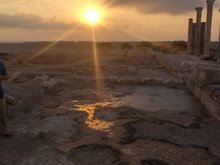Historically speaking, the term Decapolis was used to denote a league of ten cities, located primarily east of the Jordan River and the Sea of Galilee, that were connected by social, military, commercial, religious, and political ties for their mutual benefit. The league was formalized by the Roman General Pompey around 63 B.C. when his army occupied Syria and the Hasmonean Kingdom of the Jews. Initially, the region of the Decapolis seems to have been designed as a buffer zone between the Roman Empire and the Nabatean Arabs, but when Trajan conquered the Nabateans in A.D. 106 the need for this buffer disappeared. The region of the Decapolis was attached to a new province called Arabia Petraea with its capitol first located at Petra, and later moved to Bosra, Syria. Though the Decapolis ceased to be a political entity, the use of the name delineate the region continued.
Prior to our initial week of digging, we took our first weekend trip to Gadara, the modern city of Umm Qais and one of the ancient cities of the Decapolis. Excavation at Gadara is extensive, exhibiting Hellenistic and Roman architecture (three theaters, a temple, an octagonal basilica, a Roman bath house, paved streets, vaulted shops and colonnades). The city overlooks both the Sea of Galilee and northern Israel to the west. This is likely the same Gadara mentioned in each of the three Synoptic gospels as the land of the Gadarenes (Matt 8.28; Mk 5.1; Lk 8.26), where Jesus purportedly cast the legion of demons into a herd of swine. I find it interesting to read the biblical narrative of Jesus' interaction with the Gadarene demoniac while keeping in mind the city's proximity to the Sea of Galilee. Matthew records, “And [Jesus] said to them, 'Go.' So they came out and went into the swine; and behold, the whole herd rushed down the steep bank into the sea, and perished in the waters” (Matt 8.32 RSV). Gadara is actually no less than ten miles distant from the sea, meaning the herd of swine would have ran a long distance to the waters below.



















